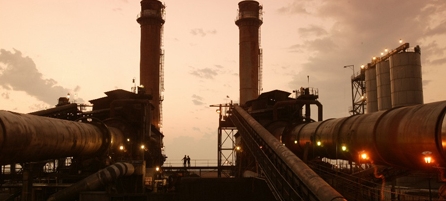
Petroleum coke is a solid byproduct of oil refinery coker units. Green coke is the raw petcoke straight out of coker. Green coke may be burned as fuel or further processed into carbon anodes that are used in steel and aluminum smelting. Calcined Petroleum Coke has a dark color, and consists of mainly carbon. The coke is available in granules, briquettes or pellets. Calcination is done in rotary ovens at temperatures between 2192 and 2460degF (1200-1350degC). Heat from rotary kilns removes moisture, impurities, and volatiles from coke. It also modifies the crystal structure to increase electrical conductivity. The calcined coke will then be ready to transport by truck, barge or railcars, to plants for aluminum, steel and concrete.
By calcining the petroleum coke using waste process gases, energy efficiency can be increased. The aim of this project was to develop and evaluate an advanced CHP system concept to best utilize the opportunity fuels (process waste off-gases) generated in the calcination process of petroleum coke. This was done by combining conventional rotary furnace calcination with electrothermal Fluidized Bed.

Energy-efficient, this innovative calcination technology can help you save significant amounts compared to the traditional method of calcining petrol coke with a rotary kiln. In addition, the technology significantly reduces greenhouse gas emissions and solid waste generation. The developed energy-efficient calcination process is therefore suitable for use in the aluminum industry as well as for other industrial applications requiring high quality, low-sulfur and low-ash calcined petroleum coke.
Around the globe, there is a rapid increase in demand for petroleum coke calcined. This is due to rising iron & steel production in developing regions, development of the cement industry and favorable government initiatives regarding the green environment.
The limited supply of low sulfur (Category A) calcined petroleum coke has driven prices upwards. As a result, many refiners are now supplementing their heavy vanadium or nickel crudes with lighter crudes that have higher sulfur. This increased GPC use, but decreased the amount imported of lighter sweet crude required to maintain refinery targets. The resulting increase in Category A GPC with higher S levels and lower API gravities may result in a higher sulfur level requirement in their smelters. In their smelters, this could lead to the need for thermal or hydrodesulfurization. This study analyzed the effect of grain size on sulfur, carbon and chemical bonding of calcined petroleum coke using ICP-MS, UV-VIS, and FTIR analysis. The results indicate that there is a strong correlation between sulfur, carbon and chemical bonding in calcined petroleum coke. Future research should consider the effects of changing the grain sizes on these properties. The results would enable the determination of the most efficient, cost-effective desulfurization technique for low sulfur petroleum coke.

Write a Message